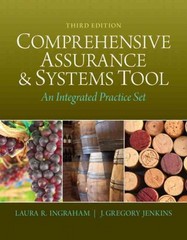Question
Multiple-Choice Questions (Theories) INTANGIBLE ASSETS 1. Which of the following are the essential characteristics of an intangible asset? a. Identifiability, controlled by enterprise, expected economic
Multiple-Choice Questions (Theories)
INTANGIBLE ASSETS
1. Which of the following are the essential characteristics of an intangible asset?
a. Identifiability, controlled by enterprise, expected economic benefits and indefinite life.
b. Identifiability, controlled by enterprise and indefinite life.
c. Identifiability, owned by enterprise, expected economic benefits and definite life.
d. Identifiability, controlled by enterprise and expected future economic benefits.
2. Which of the following does not describe intangible assets?
a. They lack physical existence.
b. They are monetary assets.
c. They provide long-term benefits.
d. They are classified as long-term assets.
3. The cost of an intangible asset includes all of the following except
a. purchase price.
b. legal fees.
c. other incidental expenses.
d. all of these are included.
4. Costs incurred internally to create intangibles are
a. capitalized.
b. capitalized if they have an indefinite life.
c. capitalized if they have a definite life.
d. expensed as incurred.
e. expensed only if they have a limited life.
5. Which of the following costs incurred internally to create an intangible asset is generally expensed?
a. Research phase costs.
b. Filing costs.
c. Legal costs.
d. All of these choices are expensed.
6. Companies should evaluate indefinite life intangible assets at least annually for:
a. recoverability.
b. amortization.
c. impairment.
d. estimated useful life.
e. Recapitalization.
7. Which intangible assets are amortized?
Limited-Life Indefinite-Life
a. Yes Yes
b. Yes No
c. No Yes
d. No No
8. The cost of purchasing patent rights for a product that might otherwise have seriously competed with one of
the purchaser's patented products should be
a. charged off in the current period.
b. amortized over the legal life of the purchased patent.
c. added to factory overhead and allocated to production of the purchaser's product.
d. amortized over the remaining estimated life of the original patent covering the product whose
market would have been impaired by competition from the newly patented product.
9. Broadway Corporation was granted a patent on a product on January 1, 2009. To protect its patent, the
corporation purchased on January 1, 2020 a patent on a competing product which was originally issued on
January 10, 2016. Because of its unique plant, Broadway Corporation does not feel the competing patent can
be used in producing a product. The cost of the competing patent should be
a. amortized over a maximum period of 20 years.
b. amortized over a maximum period of 16 years.
c. amortized over a maximum period of 9 years.
d. expensed in 2020.
10. Risen, Inc. went to court this year and successfully defended its patent from infringement by a competitor.
The cost of this defense should be charged to
a. patents and amortized over the legal life of the patent.
b. legal fees and amortized over 5 years or less.
c. expenses of the period.
d. patents and amortized over the remaining useful life of the patent.
Step by Step Solution
There are 3 Steps involved in it
Step: 1

Get Instant Access to Expert-Tailored Solutions
See step-by-step solutions with expert insights and AI powered tools for academic success
Step: 2

Step: 3

Ace Your Homework with AI
Get the answers you need in no time with our AI-driven, step-by-step assistance
Get Started


